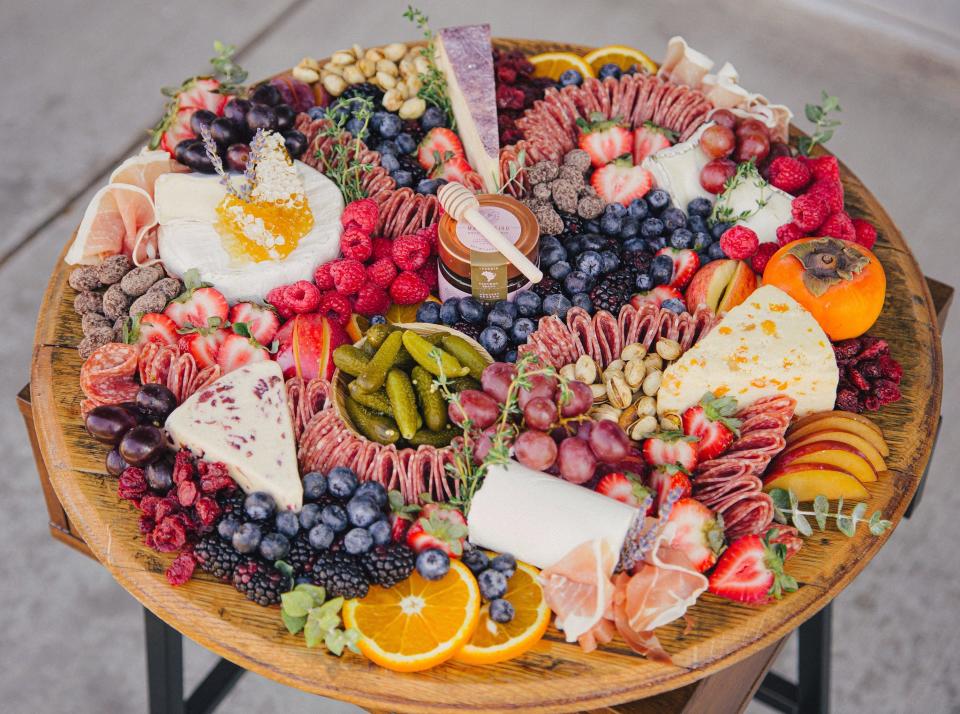Create your own charcuterie board. The guy who wrote the book on it is here to help
Meat and cheese boards might have a fancy new name these days, but don't let that intimidate you. If you have the time and inclination, you can prepare your own terrific charcuterie this holiday season.
In fact, the man who wrote the book on charcuterie is here to help.
“Some people hear charcuterie, and it sounds overwhelming. But it's not. It's sort of a ‘choose your own adventure’ way of eating a meal," said Mark LaFay, author of “Charcuterie for Dummies” and owner of Old Major market, 4011 N. Pennsylvania St.
More:6 places to find charcuterie in Indianapolis if you don't want to assemble your own
“We’ve been making meat and cheese boards in Indiana for as long as we've had meat and cheese in Indiana,” said LaFay. “But now it's in vogue, and because we’ve given it a French name, now it's cool, it’s new, and it's refreshed.”
How much to buy
The most expensive components of the board typically are going to be the meats and cheeses.
Consider if charcuterie will be a light snack or the main meal when determining the amount to buy for each serving, LaFay advises.
“One of my favorite things about the holidays is being able to pick and eat at things over a long period of time. And other people just like to put together a nice charcuterie board and sit in front of a fire and have a glass of wine and that's what they're going to do for dinner,” he said.
For a light snack, allow for ¾ to 1 ounce of meat and ¾ to 1 ounce of cheese per person.
For a heavier snack, set out 1 ¼ to 1 ½ ounce of each meat and cheese per person.
When the charcuterie is to be the main meal, have 1 ½ to 2 ounces each of meat and cheese per diner.

Selecting meats and cheeses
Don’t limit yourself to obvious choices, said LaFay, whose shop specializes in sausage and meat production, and sells charcuterie kits.
“You can go for regional things that pair well together,” he said.
For a Spanish influence, try tinned seafood, such as octopus, calamari or mussels, paired with Manchego cheese. Manchego also goes well with quince (fruit) paste.
Or go Italian with cured meats like prosciutto.
Don’t forget about spreadable meats such as pates and terrines.
High-acid items such as tart mini pickles work well with high-fat meats, and sweet jams and spreads add dimension to rich and creamy cheeses, he said.
Look for items of various textures to lay out.
“Charcuterie is as much about the texture as it is about the flavor. I like to have soft and crunchy things together, and I like to sometimes have rich and creamy things with sweet things together.”
Try a creamy brie on one side of the board and a funkier cheese on the other. Typically, harder cheeses have fuller, sharper flavors. Consider an aged Gouda, Grana Padano or a mimolette.
Other components
Fill in the board with accouterments – savory tomato or fruity jams, mustards, pickles, nuts, spreadable nut butters, and fresh or dried fruit. Put olives all over the board or put them in a small dish set on the board.
Use crackers to keep it simple, or take a French baguette, slice it on the bias, paint it with olive oil and sprinkle on a bit of sea salt before toasting for a crunchy vehicle for the meats and cheese.
Watching costs
It’s easy to work within any budget. Ingredients can come from an Aldi or a Market District. You also might be able to find the same products under a different label and at a lower price at Trader Joe’s.
“You can go as highbrow or lowbrow as you want with it,” he said.
And don’t sleep on offerings from old school Hickory Farms or Swiss Colony.
“You can do summer sausage with sharp Wisconsin cheddar cheese. That’s quintessential Americana,” LaFay said. “It’s good finger food. It’s filing at a party and it’s relatively affordable.”
Fancy it up with upscale crackers and creamy Dijon, whole grain mustard or stone-ground mustard.
Either way, a stick of sausage goes further when sliced thinly, LaFay said.
Encourage experimentation
If you love a particular combination – whether it’s cheddar cheese and apples, or brie and fig jam – position those items so that your guests can discover them, as well.
“Put things close to each other on a board that you want people to try,” LaFay said. “If you have multiple types of salami, separate them on the board, but put them next to the accoutrements you want people to try.”
“Put those things together so it sort of feels like a natural thing for them when they get to your board,” he said. “And then encourage experimentation. That’s sort of the beauty of a charcuterie board.”
This article originally appeared on Indianapolis Star: Charcuterie boards: Here's how to make your own

